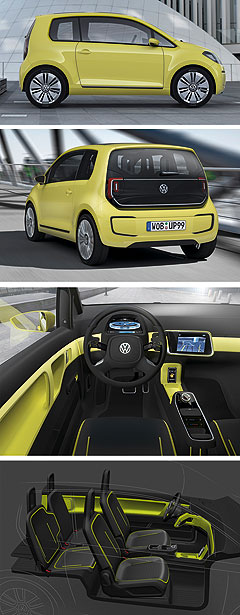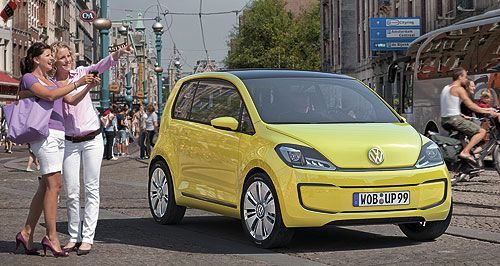Future models - Volkswagen - Up! - E-Up!First look: VW flicks switch on E-Up!Going Up!: VW Group chairman Martin Winterkorn unveils the electric E-Up! in Germany. ‘21st century Beetle’ goes electric as VW’s new baby revealed in production look15 Sep 2009 VOLKSWAGEN has unveiled an electric-powered ‘Volkswagen Beetle of the 21st century’ - the ultra-compact three-seater E-Up! - which it expects to hit the road in 2013. With a range of 130km from its lithium-ion batteries, the plug-in EV is just one of a range of Up! variants expected to reshape the VW city-car range from 2011, starting with conventional petrol and diesel models. While VW has already shown three previous Up! concepts at various motor shows over the past two years, the E-Up! revealed at this week’s Frankfurt motor show is said to be close to the design of the production Up! hatchback, using a new “VW design DNA” for the German manufacturer’s upcoming small cars, known collectively as the New Small Family. Despite its impending plunge into the EV market, VW is less than confident that electric power will be a force in the motor market in the near future, remaining a niche until perhaps 2020. Unveiling the E-Up! in Frankfurt, VW Group chairman Martin Winterkorn said that to be a genuine success, an electric car must be both affordable to a broad customer base and uncompromisingly practical in everyday driving. He said such a car would take until 2020 at the earliest to achieve sales volumes of the VW Polo light car.  “That’s why our highly efficient TDI (diesel) and TSI (petrol) engines are the most important waypoints of the present,” he said. “They will continue to be a dominant force for decades.” Just 3.19 metres long – a whopping 726mm shorter than the Polo light car, the E-Up! has what VW describes as 3+1 seating. Effectively, this comprises three real seats and one possible seat for a small child or – more likely – a baby seat or carry bag. The front passenger’s seat is positioned 50mm ahead of the driver’s seat, allowing room for the sole rear-seat passenger immediately behind. The “+1” seat is behind the driver, but with minimal legroom. The 60kW electric motor drives the front wheels, propelling the 1085kg car from 0-100km/h in 11.3 seconds and on to a top speed of 135km/h. Torque is 210Nm from rest, providing strong launch propulsion in city driving. A quarter of the car’s weight is taken up by the 18kWh battery, which lives sandwiched under the floor and needs to be mechanically cooled by fan. Forward or reverse gear is selected by a rotary knob on the centre console. VW says the battery can be charged from a home powerpoint in five hours, but like most other EVs coming on to the market, it also can be fast-charged at up to 80 per cent of capacity in one hour at higher voltage. The charging port is hidden behind the VW badge on the engine bonnet. The frontal design of the E-Up! concept is closed over, as there is no engine cooling radiator. The foglights have been cleverly disguised as C-shaped chrome-trimmed elements in the headlight housings. Like the Toyota Prius, the E-Up! gets photovoltaic solar cells on the roof, but the Up!’s cells cover a larger 1.4 square metres to top up the car’s electrical system and power a fan to ventilate the car when parked. Extra charge can be gained by folding down the sun visors, which also have solar cells on their backing.  Read moreAll future models Alfa Romeo Alfa Romeo Abarth Abarth Audi Audi Aston Martin Aston Martin BMW BMW Bentley Bentley Chrysler Chrysler Chevrolet Chevrolet Dodge Dodge Citroen Citroen Ferrari Ferrari DS DS Ford Ford Fiat Fiat FPV FPV Foton Foton Haval Haval Great Wall Great Wall Honda Honda Holden Holden Hyundai Hyundai HSV HSV Isuzu Isuzu Infiniti Infiniti Jeep Jeep Jaguar Jaguar Lamborghini Lamborghini Kia Kia Lexus Lexus Land Rover Land Rover Mazda Mazda Maserati Maserati Mercedes-Benz Mercedes-Benz McLaren McLaren Mini Mini Nissan Nissan Mitsubishi Mitsubishi Peugeot Peugeot Opel Opel Proton Proton Porsche Porsche Renault Renault Ram Ram Saab Saab Rolls-Royce Rolls-Royce Smart Smart Skoda Skoda Subaru Subaru SsangYong SsangYong Tesla Tesla Suzuki Suzuki Toyota Toyota Volvo VolvoMotor industry news |
Click to shareVolkswagen modelsResearch Volkswagen All future models Alfa Romeo Alfa Romeo Abarth Abarth Audi Audi Aston Martin Aston Martin BMW BMW Bentley Bentley Chrysler Chrysler Chevrolet Chevrolet Dodge Dodge Citroen Citroen Ferrari Ferrari DS DS Ford Ford Fiat Fiat FPV FPV Foton Foton Haval Haval Great Wall Great Wall Honda Honda Holden Holden Hyundai Hyundai HSV HSV Isuzu Isuzu Infiniti Infiniti Jeep Jeep Jaguar Jaguar Lamborghini Lamborghini Kia Kia Lexus Lexus Land Rover Land Rover Mazda Mazda Maserati Maserati Mercedes-Benz Mercedes-Benz McLaren McLaren Mini Mini Nissan Nissan Mitsubishi Mitsubishi Peugeot Peugeot Opel Opel Proton Proton Porsche Porsche Renault Renault Ram Ram Saab Saab Rolls-Royce Rolls-Royce Smart Smart Skoda Skoda Subaru Subaru SsangYong SsangYong Tesla Tesla Suzuki Suzuki Toyota Toyota Volvo VolvoMotor industry news |
















Facebook Twitter Instagram